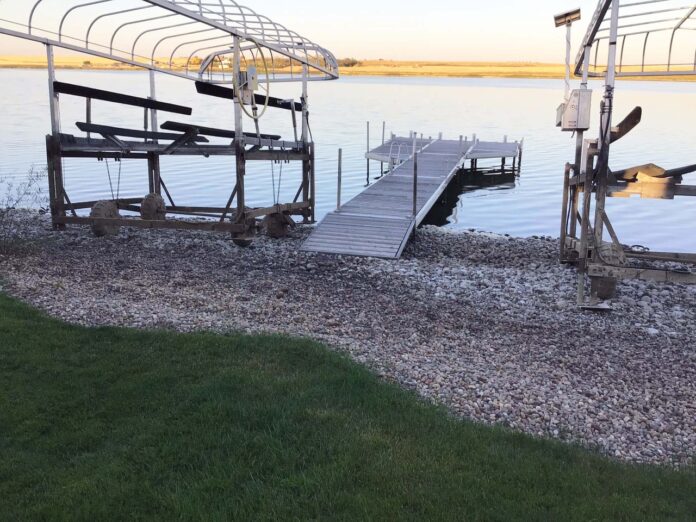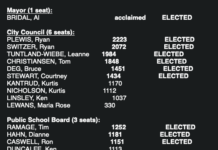
By Matthew Liebenberg
The Reid Lake Property Owners Group is raising concerns about the proposed irrigation expansion at Duncairn Reservoir after receiving a Water Security Agency (WSA) document through an access to information request.
The document provides an assessment of the potential impacts of an additional irrigation allocation of 5,000 cubic decameter (4,000 acre-feet) on fish and fish habitat.
Dwight Lemon, the co-chair of the Reid Lake Property Owners Group, felt this assessment confirms their concerns about the proposed irrigation expansion.
“My belief is with this information that the whole project should be shelved,” he said. “They should not go ahead with it.”
The fishery assessment was authored by Jeff Sereda, the WSA manager of ecological and habitat assessment. According to Lemon a number of property owners took Sereda on a boat tour around the lake last fall and he prepared the document thereafter.
“When we requested the study, WSA would not release it,” Lemon noted. “So we had to use a freedom of information request to get it. We had requested this information on several occasions.”
The Reid Lake Property Owners Group shared this document with a variety of individuals and organizations, including nature and wildlife organizations. An accompanying cover letter noted that the group is once again asking the provincial government not to go forward with the planned irrigation expansion at Duncairn Reservoir.
“The body of water is more than just another body of water to be exploited for irrigation,” the letter stated. “It is home to many species of fish and wildlife, as well as one of the few recreational areas in southwest Saskatchewan.”
The document, which is dated Oct. 16, 2023, includes a statement that this is a cursory assessment of potential impacts on fish and fish habitat. It notes that Duncairn Reservoir is a popular fishing lake and the Ministry of Environment receives many requests for stocking and slot limits as well as concerns about lake level drawdown.
There are references in the document about historical decisions taken with regard to the fish population, which is maintained through natural reproduction. There is an irrigation cutoff of 803.72 metres and a Saskatchewan Fisheries biologist requested in 1982 that water levels should not go lower to safeguard overwintering fish.
The document notes that fish spawning and rearing habitat exists at the reservoir, which requires rising or stable water levels from April to July.
A habitat analysis was done as part of the fishery assessment to evaluate the impact of an additional irrigation allocation of 5,000 cubic decameter. It found that the median reservoir surface area will be reduced by 73 to 96 hectares from April through July.
The drawdown rate will increase two to tenfold and the loss of surface area through drawdown will increase 1.5 to eight-fold from April through June. The frequency of conservation drawdown limit violations will nearly double from December through March, which could result in winterkill.
The potential threat to the fisheries includes a loss of shoreline habitat for spawning and rearing. The reservoir may have less storage capacity than modeled for this analysis due to sedimentation. Updated bathymetric data about water depth is therefore required to model actual habitat losses.
There is no recent information about the status of the fishery, which means that population trends in relation to water management cannot be done. Five or more consecutive years of fishery data is needed for this purpose.
The document indicates that winterkill as a result of regular and predictable violations of the conservation drawdown limit will be perceived as negligence and a contravention of the federal Fisheries Act. It is therefore recommended that WSA engages with Fisheries and Oceans Canada about the proposed changes to reservoir operations.
Lemon felt the information provided in this WSA document supports the position of the Reid Lake Property Owners Group.
“There’s already irrigation taking place out of the dam,” he said. “So what we’re against is the expansion of the irrigation, because under their own numbers, it shows that the conservation drawdown limit will be reached 50 per cent of the time. That should be a wake-up call for the City of Swift Current, because they may be guaranteed the water, but the quality will be hampered. It won’t be great quality of water. It will cost the City more money to process it.”
He noted that the results of this fishery assessment serve to highlight the need for other assessments about the potential impact of the proposed irrigation expansion.
“It’s something that they should do,” he said. “If you’re looking at a project, you should prudently study all impacts. You should be doing a recreational study. You should be doing an economic study. It should be doing studies for the wildlife and the fish, the quality of water. What’s the impacts downstream?”
He felt the Reid Lake Property Owners Group has been effective in raising awareness about the concerns that exist about this proposed project.
“I think we’ve been able to bring it to light,” he said. “There are more people talking about it today than there was back in August. … But as far as swaying the government, I don’t know if we’ve had any success. We hope to, through public pressure. That’s what we hope to be able to do. I don’t know if we’re going to be successful, but we’re hoping that we can change the government’s view.”
Note: A media request was submitted to the WSA, asking for comments about the fishery assessment report and the status quo of their assessment of irrigation expansion at Duncairn Reservoir. A WSA spokesperson indicated there will be a response, but information was not received before the specified story deadline.





